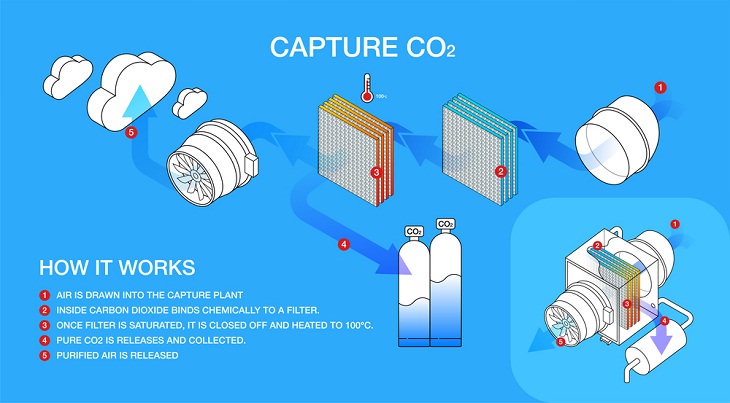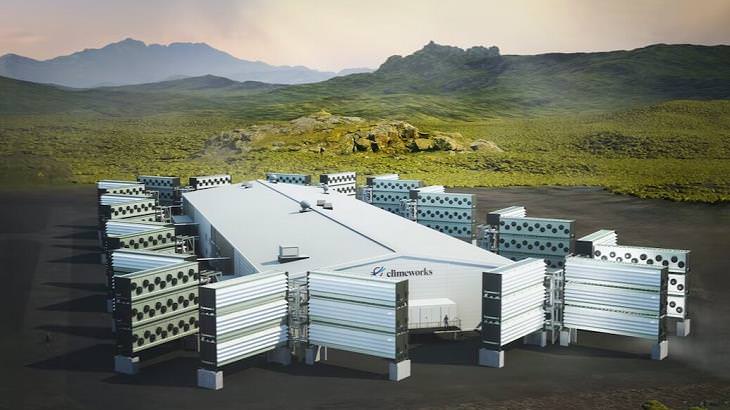To limit the worst outcomes of climate change, we need to take a lot of carbon dioxide out of the air. The Intergovernmental Panel on Climate Change (IPCC), a Paris-based intergovernmental energy organization, notes that our planet will be 2–3 degrees hotter by the end of this century, and to curtail that, removing carbon dioxide (CO2) from the atmosphere will be crucial. This is because the amount of carbon emissions the planet is producing right now is so high that the concentration of carbon dioxide in the air keeps increasing at an alarming speed. According to the IPCC, the total global carbon dioxide emissions released into the air in 2021 were 36.3 billion metric tons.
It is difficult to eliminate carbon emissions from agriculture and air travel. So, how do we pull carbon dioxide out of the air to stop climate change? Reforestation helps, but climate change experts say that we can’t plant enough trees and plants to do the job alone. Therefore, researchers are developing alternative ways to do this.
One of the suggested solutions involves building carbon capture plants. This technology has been used on a small scale so far, but now, the world’s largest direct air capture (DAC) plant in Iceland promises to combat climate change by sucking 36,000 metric tons of carbon dioxide from the air every year.
What will the new DAC plant do?
So, what exactly is the purpose of a DAC plant? DAC plants essentially extract CO2 directly from the atmosphere. Among the main advantages is that DAC plants can be deployed anywhere and remove massive quantities of carbon dioxide from the air. DAC plants are considered to have great potential, as there is no limit to the amount of CO2 that can be captured with the DAC technology.
DAC uses blocks of industrial-scale fans and sorbent filters that suck in air and extract its CO2. The filters, which chemically bind with CO2, need to be heated and placed under a vacuum. This allows them to capture the concentrated CO2. The captured carbon is then compressed under extremely high pressure before being mixed with water and injected underground, where a chemical reaction converts it to rock.
The world’s largest carbon capture plant in Iceland is under construction by the Swiss company Climeworks in partnership with the Icelandic carbon storage firm Carbfix. Named Mammoth, this plant will have the capacity of capturing 36,000 tons of CO2 every year (that’s equal to the annual emissions of about 6,300 cars).
Mammoth will have 80 containers (blocks of fans and filters that will suck in air and extract its CO2). The facility will be powered by renewable energy from a geothermal power plant nearby. The company says that 90 percent of the CO2 the plant brings in will be permanently captured. Construction of the Mammoth plant is expected to be complete in 18 to 24 months.
Artist rendering of the new carbon capture plant announced by Climeworks. (Image source:
Climeworks)
The International Energy Agency observes that 19 DAC plants are currently operating worldwide. Together, they capture 10,000 tons of carbon dioxide a year. The addition of Mammoth will be a huge boost. Reports say that another plant with the capacity of capturing one million metric tons of CO2 per year is coming up in Texas by this December.
DAC technology has improved significantly over the years. “We started with milligrams of carbon dioxide captured from the air,” said Jan Wurzbacher, CEO, and Founder of Climeworks, to CNBC. “Then we went from milligrams to grams, from grams to kilograms to tons to 1,000 tons.”
The company is now aiming to get rid of millions of tons of CO2 per year by 2030 and a billion per year by 2050.
One big drawback of the DAC technology is its high energy usage. Reportedly, Mammoth will require 303 megawatts of electricity and 400 megawatts of thermal energy to function. Add the construction and maintenance costs, and this becomes an extremely expensive endeavor. Will it be worth all the effort? These are the sorts of questions that will need to be addressed as we continue our fight against climate change.
For now, it’s still unclear whether direct air capture will be a viable solution. Experts insist that addressing climate change will require investment in technologies that help limit future emissions, and DAC might well be a gamble worth taking.
Share this post with friends and family.


